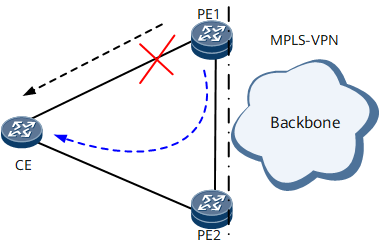Fault on the Downlink Interface on a PE - IP FRR
In IP FRR scenarios, when the primary path between a CE and a PE fails, traffic switches to the bypass path.
As shown in Figure 1, PE1 has two paths to reach the CE. One is the path PE1 -> CE, and the other is PE1 -> PE2 -> CE. In normal circumstances, traffic to the CE is forwarded by PE1 (the primary PE). If the link between PE1 and the CE fails, IP FRR switches the traffic from the link between PE1 and the CE to the link between PE2 and the CE.
Generally, a PE accesses a Layer 3 virtual private network (L3VPN). When IP FRR is used for a private network, a private network neighbor relationship must be established between PE1 and PE2. The primary and bypass paths are created for PE1 to access the CE.

If both LDP FRR and IP FRR are available, IP FRR is preferred.
